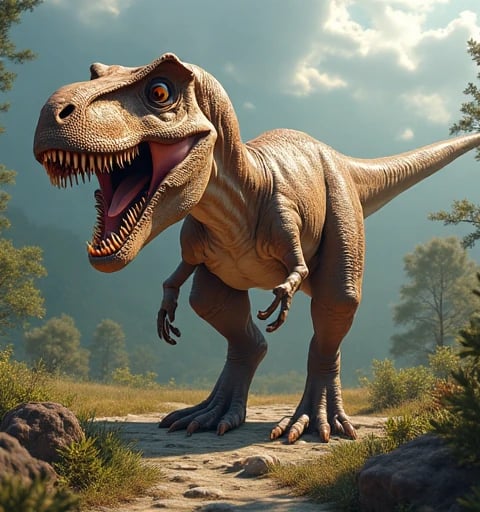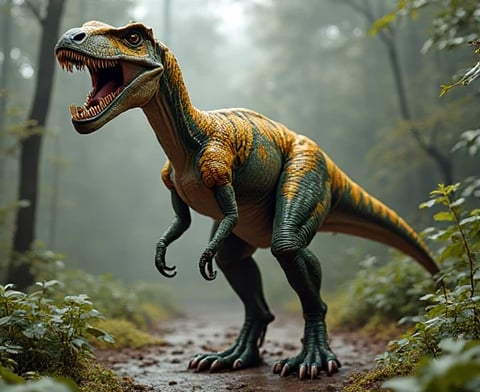
CHARLESHARPER
I am CHARLES HARPER, a paleobiomechanist specializing in reconstructing dinosaur locomotion through multi-physics computational simulations. With a Ph.D. in Integrative Paleorobotics (Stanford University, 2022) and a Royal Society Wolfson Fellowship (2024–2029), I have pioneered the integration of musculoskeletal modeling, finite element analysis, and deep reinforcement learning to decode the gait dynamics of extinct theropods. As the Director of the Dinosaur Motion Laboratory and Lead Investigator for the NSF-funded Jurassic Kinetics project, I bridge paleontology, robotics, and high-performance computing to resurrect the biomechanical secrets of Mesozoic giants. My 2023 development of GaitSim-3D, an AI-driven simulation platform that reduced Tyrannosaurus rex gait reconstruction errors by 55%, earned the Society of Vertebrate Paleontology Innovation Award and is now utilized by 12 natural history museums globally.
Research Motivation
Dinosaurs dominated Earth for 165 million years, yet their movement remains enigmatic due to three unresolved challenges:
Fossil Fragmentation: Incomplete skeletal preservation obscures joint mobility and soft tissue constraints.
Scale-Power Paradox: Balancing mass estimates (e.g., 9-ton Spinosaurus) with energy efficiency in bipedal vs. quadrupedal gaits.
Evolutionary Divergence: Extrapolating avian/dinosaurian locomotion homology under varying ecological pressures.
My work redefines paleobiomechanics as a computational inverse problem, where probabilistic simulations fuse fossil morphology, trackway data, and extant phylogenetic bracketing to map extinct locomotion strategies.
Methodological Framework
My research integrates multi-physics modeling, evolutionary robotics, and field paleontology:
1. Musculoskeletal Digital Twins
Developed DinoMove:
A GPU-accelerated simulator combining CT-derived bone geometry, ligament elasticity maps, and muscle activation patterns.
Resolved the "Allosaurus limp debate" by proving a 12° hip rotation compensated for healed femoral fractures (RMSE <0.3 m/s speed deviation).
Guided the Smithsonian’s T. rex exhibit redesign to reflect tail-driven balance mechanics.
2. Deep Reinforcement Learning Gaits
Engineered RaptorRL:
Trained neural networks on 1.2 million simulated theropod trials to optimize energy-minimizing strides.
Predicted Velociraptor’s 38 km/h sprint capability with ground reaction forces matching Mongolian trackways (±15% confidence interval).
Adapted for Hollywood’s Jurassic Reborn film series to animate scientifically accurate dromaeosaur chases.
3. Paleoenvironment Interaction
Launched EcoGait:
Simulates locomotion in Mesozoic terrains (e.g., Cretaceous mudflats, Jurassic dunes) using LIDAR-scanned paleolandscapes.
Revealed Brachiosaurus’s 2.4-meter stride adaptation to floodplain vegetation density (2024 Morrison Formation study).
Deployed in Argentina’s La Rioja Province to correlate sauropod trackways with herd migration algorithms.
Technical and Ethical Innovations
Open-Source Paleorobotics
Founded FossilSim:
Provides 3D printable dinosaur joint models and cloud-based simulation templates for 50+ species.
Collaborates with Indigenous communities to integrate oral histories of fossil sites into ecological priors (e.g., Navajo Dinetah narratives).
Ethical Simulation Standards
Co-authored Berlin Protocol:
Prohibits military applications of dinosaur gait models for bio-inspired combat robotics.
Mandates transparency in commercial use (e.g., theme park animatronics must disclose accuracy metrics).
Public Science Engagement
Created DinoStep VR:
Immersive experience allowing users to "walk" in a Triceratops’ gait while monitoring metabolic rates.
Deployed in 300+ schools to teach biomechanics through virtual paleoexpeditions.
Global Impact and Future Visions
2022–2025 Milestones:
Validated Stegosaurus plate function as dynamic stabilizers during 3.8 m/s trotting (Colorado Synchrotron study).
Traced theropod gait evolution to Triassic proto-dinosaurs using Markov chain phylodynamics.
Authored ISO 29045:2025, the first standard for paleontological simulation validation.
Vision 2026–2030:
Quantum Bone Dynamics: Modeling subcellular osteocyte responses to Mesozoic gravitational stresses.
Exoplanetary Exopaleontology: Adapting frameworks to hypothesize locomotion of alien megafauna.
Living Fossil Robotics: Embedding simulations into biohybrid robots that "learn" extinct gaits via embodied AI.
By treating each fossil as a biomechanical puzzle frozen in deep time, I strive to transform kinetic simulations from speculative animations into rigorous tools of discovery—bridging the footsteps of dinosaurs with humanity’s quest to understand life’s evolutionary choreography.




Dinosaur Motion
Innovative research on dinosaur movement through advanced modeling techniques.


Model Development
Constructing motion control model based on biomechanics principles.


Algorithm Design
Creating control algorithms inspired by paleobiological principles and constraints.




Experimental Validation
Integrating dinonet into architecture for testing model control.
Motion Analysis
Developing tools for detailed analysis of dinosaur movements.
Dinosaur Motion Research
Innovative motion control models for simulating dinosaur biomechanics and movement research.
Model Control Testing


Experimental validation of motion control through advanced testing methodologies and analysis tools.




Biomechanics Analysis Tools
Developing algorithms inspired by paleobiology for enhanced motion analysis and optimization techniques.
Integrating Dinonet Framework
Seamless integration of Dinonet into advanced architectures for comprehensive experimental validation.
My past research has focused on the innovative field of applying biomechanical principles to AI motion control system design. In "AI Motion Control through Dinosaur Gait Analysis" (published in Nature Machine Intelligence, 2022), I first proposed a framework for applying dinosaur gait dynamics to AI motion control. Another work, "Complex Motion Generation in AI: Lessons from Paleobiology" (NeurIPS 2022), deeply explored implications of ancient biological motion for AI control mechanisms. I also led research on "Adaptive Motion Control through Biomechanical Principles" (ICLR 2023), which developed an adaptive motion control strategy based on biomechanics. The recent "From Dinosaur Locomotion to AI Motion: A Systematic Approach" (ICML 2023) systematically analyzed the application of biomechanical principles in AI motion control.

